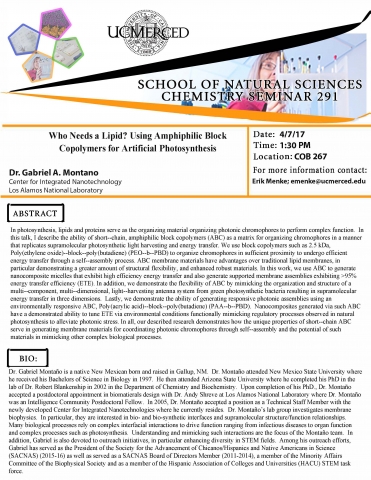Gabriel A. Montano, Los Alamos National Lab
Abstract:
In photosynthesis, lipids and proteins serve as the organizing material organizing photonic chromophores to perform complex function. In this talk, I describe the ability of short--‐chain, amphiphilic block copolymers (ABC) as a matrix for organizing chromophores in a manner that replicates supramolecular photosynthetic light harvesting and energy transfer. We use block copolymers such as 2.5 kDa, Poly(ethylene oxide)--‐block--‐poly(butadiene) (PEO--‐b--‐PBD) to organize chromophores in sufficient proximity to undergo efficient energy transfer through a self--‐assembly process. ABC membrane materials have advantages over traditional lipid membranes, in particular demonstrating a greater amount of structural flexibility, and enhanced robust materials. In this work, we use ABC to generate nanocomposite micelles that exhibit high efficiency energy transfer and also generate supported membrane assemblies exhibiting >95% energy transfer efficiency (ETE). In addition, we demonstrate the flexibility of ABC by mimicking the organization and structure of a multi--‐component, multi--‐dimensional, light--‐harvesting antenna system from green photosynthetic bacteria resulting in supramolecular energy transfer in three dimensions. Lastly, we demonstrate the ability of generating responsive photonic assemblies using an environmentally responsive ABC, Poly(acrylic acid)--‐block--‐poly(butadiene) (PAA--‐b--‐PBD). Nanocomposites generated via such ABC have a demonstrated ability to tune ETE via environmental conditions functionally mimicking regulatory processes observed in natural photosynthesis to alleviate photonic stress. In all, our described research demonstrates how the unique properties of short--‐chain ABC serve in generating membrane materials for coordinating photonic chromophores through self--‐assembly and the potential of such materials in mimicking other complex biological processes.




